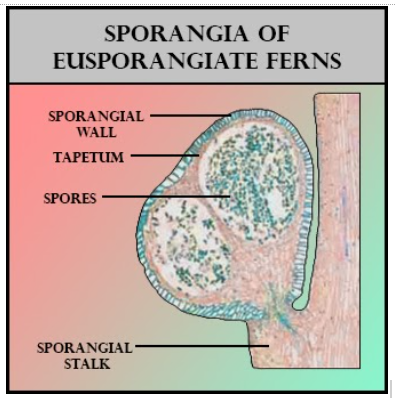
Sporangia of eusporangiate ferns
(a)Possess a single layer of wall cells
(b)Produce very few spores
(c)Originate from a group of initial cells
(d)Dehiscence at the region of a wall defined stomium
Answer
502.2k+ views
Hint: Vascular spore plants, whose sporangia originate from multiple epidermal cells, are Eusporangiate ferns. They contain specialized ring-shaped cells for spore release. Up to 7000 spores are produced by the Christensenia fern per sporangium. A periclinal wall, containing an outer and inner daughter cell, separates a superficial cell.
Complete answer:
There is a large sporangium in Eusporangiate ferns that grows from many initial cells that contain several spores. The sporangium fuses in certain instances to form Synangium. E.g., Selaginella and Psilotum. These ferns usually have reduced root systems and sporangia that contain large quantities of spores. E.g., Psilotum, Equisetum, etc.
The sporangia are thin-walled and an area of cells with thick inner walls and thin outer walls, causes dehiscence, generally in a ring called the annulus.
Additional Information: An annulus on the sporangium is an arc or a ring of specialized cells. These cells are grouped in one row and are associated with spore release or dispersal.
Leptosporangiate has a small sporangium and it grows from a single initial cell. They are capable of producing a small, definite number of spores (Less than 128).
So, the correct answer is, ‘Originate from a group of initial cells’.
Note: -A sporangium (the plural form is known as sporangia) is the capsule structure of many plants and fungi that produces and stores reproductive spores. Via meiosis, most sporangia create haploid spores, although some can develop spores via mitosis.
-Both land plants undergo an alteration to replicate over centuries. The sporangium is held by the sporophyte.

Complete answer:
There is a large sporangium in Eusporangiate ferns that grows from many initial cells that contain several spores. The sporangium fuses in certain instances to form Synangium. E.g., Selaginella and Psilotum. These ferns usually have reduced root systems and sporangia that contain large quantities of spores. E.g., Psilotum, Equisetum, etc.
The sporangia are thin-walled and an area of cells with thick inner walls and thin outer walls, causes dehiscence, generally in a ring called the annulus.
Additional Information: An annulus on the sporangium is an arc or a ring of specialized cells. These cells are grouped in one row and are associated with spore release or dispersal.
Leptosporangiate has a small sporangium and it grows from a single initial cell. They are capable of producing a small, definite number of spores (Less than 128).
So, the correct answer is, ‘Originate from a group of initial cells’.
Note: -A sporangium (the plural form is known as sporangia) is the capsule structure of many plants and fungi that produces and stores reproductive spores. Via meiosis, most sporangia create haploid spores, although some can develop spores via mitosis.
-Both land plants undergo an alteration to replicate over centuries. The sporangium is held by the sporophyte.

Latest Vedantu courses for you
Grade 10 | CBSE | SCHOOL | English
Vedantu 10 CBSE Pro Course - (2025-26)
School Full course for CBSE students
₹37,300 per year
Recently Updated Pages
Master Class 11 Economics: Engaging Questions & Answers for Success

Master Class 11 Business Studies: Engaging Questions & Answers for Success

Master Class 11 Accountancy: Engaging Questions & Answers for Success

Master Class 11 English: Engaging Questions & Answers for Success

Master Class 11 Computer Science: Engaging Questions & Answers for Success

Master Class 11 Maths: Engaging Questions & Answers for Success

Trending doubts
Which one is a true fish A Jellyfish B Starfish C Dogfish class 11 biology CBSE

State and prove Bernoullis theorem class 11 physics CBSE

1 ton equals to A 100 kg B 1000 kg C 10 kg D 10000 class 11 physics CBSE

In which part of the body the blood is purified oxygenation class 11 biology CBSE

One Metric ton is equal to kg A 10000 B 1000 C 100 class 11 physics CBSE

Difference Between Prokaryotic Cells and Eukaryotic Cells




